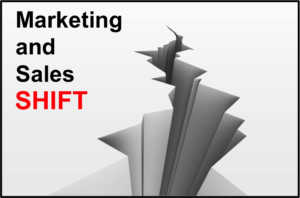
Blog
The Anonymous Buyer Journey - Part 2: The Sales and Marketing Shift

 Having set the core foundation with an effective sales equation, our second post in this series examines the shift between marketing and sales for the anonymous buyer journey.
Having set the core foundation with an effective sales equation, our second post in this series examines the shift between marketing and sales for the anonymous buyer journey.
The old school relationship between marketing and sales producing “contacts” for sales overviews pushed by high volume campaigns of email and voice mail has driven prospects into an anonymous buyer profile. Today an estimated 70-80% of the buyer’s journey is anonymous avoiding lead forms, emails, and calls for sales engagement as they learn about possible solutions online. The roles of marketing and sales have shifted, and those that understand this shift are poised for success.
People have less time and the odds of being invited to a prospect for a one-hour meeting for an introduction, overview presentation, and planning discussion are about zero today. Buyers are online and increasingly prefer an anonymous profile for most of the buying cycle until they engage where they expect expertise. This is also why the first post in this series was on the importance of a solid sales equation for anonymous buyers driving this shift.
The characteristics of the shift between marketing and sales include the following:
Inside Sales – becomes part of marketing driven by account based marketing (ABM) programs to map and correlate the multiple touch points of prospects (and customers) as they follow a non-linear and longer online nurturing process. Inside sales and marketing work together as a team leveraging high quality educational content and context. Digital signals from web, email and social content often produce multiple touch points per prospect to validate interest. Inside sales should test, rinse and repeat to reuse high scoring elements measuring their analytics. Content is king as well as context for industry categories.
Outbound Sales – now experience more educated and experienced prospects due to the anonymous buyer’s journey where they are in the last 20-30% of the buying cycle when they engage with outbound sales. It is often stated the car buyer today knows more than the sales person about a specific model, engine and trim package. This shift changes the game for outbound sales; they need to have the product expertise and competitive knowledge levels normally found in product marketing. Buyers expect expertise late in the buying cycle and sales for the most part has one shot with prospects. The high value experience of online content and context has to continue into the audible-ready skills of outbound sales.
Training – changes for sales and marketing teams due to this shift. Marketing and inside sales need to understand analytics for all touch points from prospects and customers. Knowledge and expertise on the marketing automation stack for these analytics and changing from a “spam cannon” to a “contextual rifle” becomes key for success. Interested prospects and customers value educational content and insights over lures, gift cards and prizes.
Sales training has to go deeper into solution expertise and competitive comparisons as buyers expect this knowledge from the first meeting onward. Why is your solution better and what are the results? This gets back to the New York City one-minute meeting test of being audible ready, concise and knowledgeable. Try it, can you pass the test for your solution or service?
Content – becomes more concise, clear and impactful as people have less time for long storyboards, large papers and reports or one-hour videos. The eye sweep, often from upper left to lower right, results in headlines and sub-heads being absorbed while long paragraphs get looked over. Trust in peers, their projects and results, and their recommendations outweigh lab tests, canned case studies and numerous awards. This changes what marketing and inside sales leverages for content and how outbound sales communicate the sales equation for their solution. The conversation is more about the prospect and validation comes from their peers.
Warning Signs - that your company needs to make the shift include long overview presentations that repeat known facts about a problem, plus the company history, journey and portfolio. Look for a haystack of contacts (often incorrectly called leads) from marketing that sales refuse to engage, as they are not qualified and a waste of their time. Also sales teams using old contact lists and rolodexes of the past are finding people change roles, jobs and companies more frequently today and they are missing new prospects and their digital signals of a non-linear online journey.
Recognize the engagement shift between marketing, inside sales and outbound sales due to anonymous buyers who increasingly prefer gathering information on their own than working with a sales person. Training and content also have to shift for effectiveness with these teams. Buyers today expect expertise when they engage with sales at a product marketing level and are likely to find your company online from content that educates and provides insights.
The next blog in this series will look at the evolution of inside sales and why this team is quickly expanding under marketing leadership to nurture and analyze analytics.


